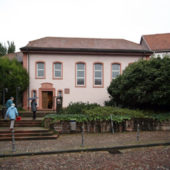The former Gelnhausen synagogue now an exhibition space.
The beautifully restored Synagogue in Gelnhausen has an interesting history and gone through many transformations.
By the Middle Ages, there was an established Jewish community in Gelnhausen, with a synagogue called 1337th. In the 13th century, the Jewish community lived in the city. In 1347 an imperial tax was levied against the Jews, of £200 per person. In the beginning of the 14th century, Jews had to live in the “Jewish ghetto,” the area formerly known as Kuhgasse and the lower market, which was below today’s Brentano Lane.
The plague in June of 1349 wiped out much of the Jewish population. Those remaining were blamed for the plague and persecuted. The Synagogue and a new one were built on the “Jewish Street” (today Brentano Lane). From 1360 to 1362, Jews immigrated from towns all over Germany to Gelnhausen. In 1425, the Jewish community numbered 61 people, whose occupations were predominately money lending. This was because it was frowned upon for Christians to be moneylenders, although they would happily borrow money from Jews, who would offer better interest rates than banks. However, the Jews continued to be heavily penalized by unfair taxes and “charges.”
In 1576, all Jews were expelled from the city to make the city a “Judenfre” (Jewish-free) city; however, by 1599, three families had returned. In 1601 a new Synagogue was built, on the present Synagogue’s current site. In 1701 Rebe Henoch Judah Halevi taught in Gelnhausen and he and his successors made the town a center for learning for rabbis. By 1734, there were 33 Jewish families in the community. The community grew to approximately 60 families by 1750. The famous halachist Rabbi Loeb ben Yeuda, who authored several rabbinical treatises, lived in the city.
During the first half of the 18th century, the “Jewish Street’s” gates were closed at night. In 1836 the Jewish public religious school was founded and anyone could attend. It was integrated into the state school system. The first teacher was Hirsch Schlesinger. By 1835 there were 231 Jewish people in the community. In 1925, the Jewish community was tremendously active, with organizations involved with health care, assisting the needy, a funeral association, burial services, a First World War survival fund, supporting war orphans, etc. By 1933, as anti-Semitism increased, the community had decreased in numbers to 162. At that time, there was a boycott against Jewish vendors or Jewish products; therefore, more of the community left the city. In 1938, Zev William Lang was the last Jewish religious teacher, due to the significant Nazi threat. Beginning in June 1938 the Jews of Gelnhausen began to prepare for pogrom night, when they would all have to leave the city by the September 1, 1938; again, another “Judenfre” period in Gelnhausen’s history. After World War II about 60 to 70 displaced Jews trickled back into Gelnhausen.
In 1601 the Synagogue was built on its current site. However, it was destroyed in the Thirty Years War, but rebuilt in 1656. In 1736, further expansion and rebuilding of the Synagogue took place and in 1740 the Aron-Kodesh was installed on the East wall. In 1836 the first Jewish elementary and religious school in Gelnhausen was founded, a mikvah (ritual bath) was built in the synagogue, and a cemetery was procured. By the middle of the 19th century Gelnhausen became a significant center for scholarly Rabbinertums. It is said that in 1817, the ascetic and scholarly Rabbi Samuel Warburg, died with his hands lifted up in prayer in the synagogue.
During World War II there was some damage to the Synagogue due to shelling. It was subsequently used as a warehouse. In 1969, the Synagogue was sold to a car mechanics guild and the Synagogue itself became a car garage. The Jewish community tried many times to negotiate a purchase with the owner; however, terms could not be agreed upon. Finally, on July 24, 1981 the city, in combination with the Jewish community of Hessen (which includes Frankfort), acquired the Synagogue, in order to restore and return it to the Jewish community. On September 25, 1986, Gelnhausen Synagogue’s doors were opened as a museum and cultural center.
The Synagogue is an excellent example of Baroque styling. The façade is cream stuccowork. Double wood entry doors, surrounded by elegant baroque molding in terracotta complete the elegant entranceway. Inside the prayer-room, features ivory walls with inset arched windows along the East and South walls, with terracotta tiles surrounding the window insets. The ceiling is decorated with baroque designs using wedgewood blue, terracotta, tan and light green. A large, ivory, multi-armed chandelier drops down from the center of the ceiling. In the center of the East wall are tiles with elaborate motifs. The Aron-Kodesh, which does not possess a torah, is covered with a screen. The floor is tiled with ivory, peach and light blue marble.
The Gelnhausen Synagogue, which has been torn down and re-built, rested in the hands of its enemies, used as a warehouse and garage, is finally back in the hands of the Jewish community. Although it no longer serves as a Synagogue, its presence as a Museum testifies to the long history, culture and faith of the Jewish people who once lived in Gelnhausen.


